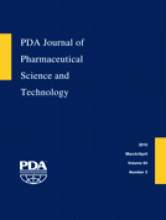Abstract
Vascular access of patients by peripheral and central venous catheters for the delivery of sterile or aseptically manufactured parenterals is commonly regarded as one of the major causes of blood stream infections. Rigorous evaluation and management of the risks of microbial infection originating from the administration of aseptically manufactured therapies remain imperative to reduce patient infection risks. Healthcare clinicians are continually faced with choosing intravenous (IV) parenteral administration strategies to minimize patient blood stream infection risk. Data facilitating such decisions are often difficult to obtain. Analysis and interpretation of the available, reported hospital infection rate data to evaluate medical device- and therapy-associated infection rates are constrained by the variability and uncertainty associated with each individual administration scenario. Moreover, clinical trials quantifying infection risk are constrained by their practicality, cost, and the control of the exacting requisite trial criteria. Furthermore, it is ethically inappropriate to systematically conduct clinical evaluations incorporating conditions that do not favor the best possible patient outcomes. Quantitative risk modeling (QRM) is a unique tool offering an alternative and affective means of assessing design and clinical use in the context of the clinical environment on medical device and combinatorial therapy infection rates.
Here, we report the generation of QRMs and the evaluation of manual admixing IV bags for use in IV administration sets upon patient infection rates. The manual admixing of IV bags was assessed for the opportunity and risk of microbial ingress accessing across the sterile barrier during clinical preparation and contaminating the IV solution. The risk of microbial contamination was evaluated under (a) ISO 5 compounding conditions adopting ideal aseptic technique (in compliance with USP 〈797〉) and (b) realistic worst-case point-of-care conditions (typically found in hospital wards). These choices of conditions encompass the complete spectrum of clinical environments encountered in the hospital. The evaluation estimated contamination rates ranged from <2.2 ppm (2.2 contaminated units in every million uses) to 2.9% (29 contaminated units in every 1000 uses), contingent upon the clinical environment. QRM permits the swift probabilistic evaluation of contamination rates providing the healthcare professional with data to make an informed choice of medical devices and a preparation strategy in their precise clinical context, reducing hospital acquired infections for optimal clinical patient outcomes.
- © PDA, Inc. 2010
PDA members receive access to all articles published in the current year and previous volume year. Institutional subscribers received access to all content. Log in below to receive access to this article if you are either of these.
If you are neither or you are a PDA member trying to access an article outside of your membership license, then you must purchase access to this article (below). If you do not have a username or password for JPST, you will be required to create an account prior to purchasing.
Full issue PDFs are for PDA members only.
Note to pda.org users
The PDA and PDA bookstore websites (www.pda.org and www.pda.org/bookstore) are separate websites from the PDA JPST website. When you first join PDA, your initial UserID and Password are sent to HighWirePress to create your PDA JPST account. Subsequent UserrID and Password changes required at the PDA websites will not pass on to PDA JPST and vice versa. If you forget your PDA JPST UserID and/or Password, you can request help to retrieve UserID and reset Password below.






